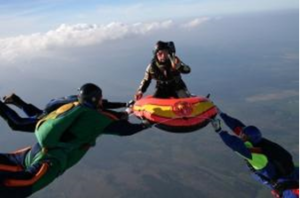As human activities are made safer, it tends to make us overconfident and take higher risks. This unintended consequence of increased safety has vast implications including, but not limited to, adventure sports, road safety, and stock markets.
Question for you. How many parachutes does one need to try skydiving? One, two?
Technically, none. That is if you want to jump only once. To do it more than once you need the parachute. Don’t you?
Well, I agree this was a weak attempt of starting this post with humour. But on a serious note, I am sure you know that every skydiver jumps with a reserve parachute. And what if the both the chutes don’t open? Well…so much for skydiving!
Instead of wondering about the number of parachutes, a more interesting question to ask here is this: does an additional chute make skydiving safer? “Of course! It should,” most people will argue, “When a skydiver knows that there’s a backup for the emergency, wouldn’t he feel safer? Isn’t that the reason skydiving, as a sport, has become so popular that hundreds of thousands of people indulge in it every year?”
But if you dig deeper into above statement, you’d realise that there lies the paradox of safety. Statistics reveal that even though skydiving equipment has made huge leaps forward for improving reliability, the fatality rate has stayed roughly constant when adjusted for the increasing number of participants.
The backup parachute and other safety measures seem to reduce the risk only for a short while until the skydivers start feeling safer and, unfortunately, overconfident. This overconfidence promotes the skydivers to attempt even riskier manoeuvres which defeats the purpose of having the additional safety.
Skydiving pioneer Bill Booth observed – “The safer skydiving gear becomes, the more chances skydivers will take, in order to keep the fatality rate constant.”
This phenomenon isn’t limited to skydiving alone. Take skiing for example. Recent studies indicate that skiers wearing helmets go faster on average than non-helmeted skiers, and that overall risk index is higher in helmeted skiers than non-helmeted skiers. Moreover, while helmets may help prevent minor head injuries, increased usage of safety headgear has not reduced the overall fatality rate.
So, am I arguing that people should stop wearing helmets and jump with a single chute only? No. That would be a defeatist view. My intention is to draw your attention to a less known behavioural bias called Peltzman Effect.
- Spotlight: Big ideas from Value Investing and why applying them in your investment decision making will be a great deal
- InvestorInsights: Interviews with experienced value investors, learners, and deep thinkers
- StockTalk: Thorough analysis of business models of companies (without any recommendations)
- Behaviouronomics: Deep analysis of human behaviour and how it impacts investment decision making
- BookWorm: Reviews of the best books on Value Investing and related subjects
- Free Course – Financial Statement Analysis for Smart People (otherwise priced at Rs 5,900)
- Archives: Instant access to our huge archive from the past three years
